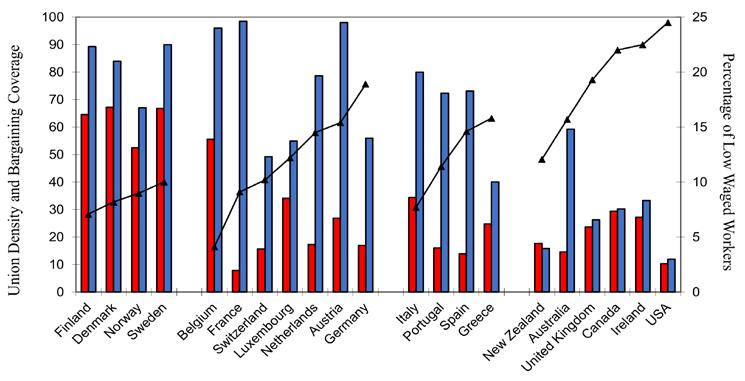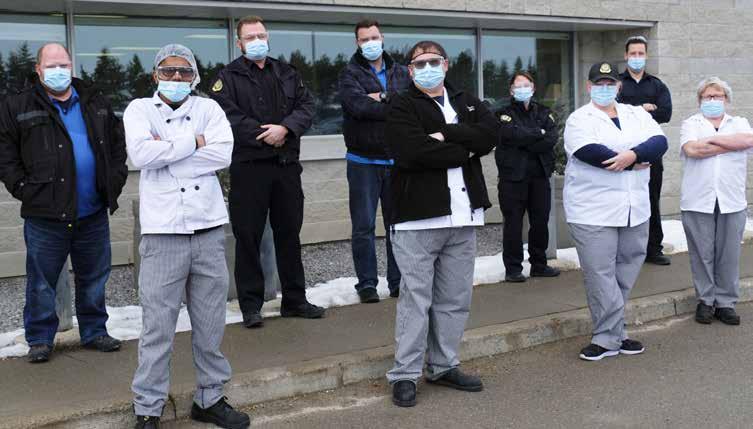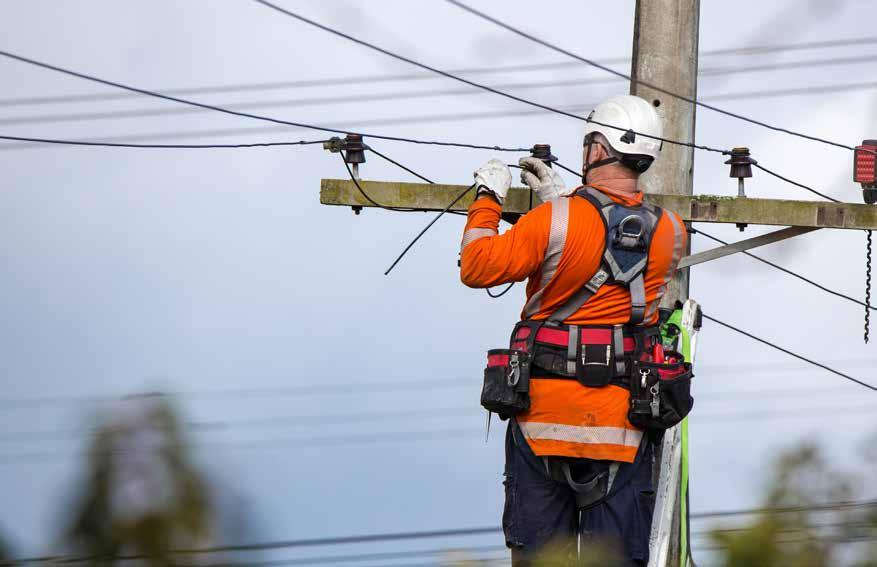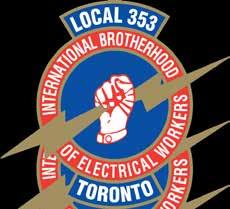
16 minute read
Cover Story
Belonging to a union is good for your health
DENNIS RAPHAEL AND JESSICA MULLER
Advertisement
Dr. Dennis Raphael is a professor of health policy and management at York University. Jessica Muller is an MA student in the graduate program of health policy and equity at York University.
Living and working conditions are the primary factors that shape whether individuals stay healthy or become ill; they are much more important than biological markers or behavioural choices. This truism applies to just about every physical, mental or social affliction that one may encounter. The term social determinants of health (SDOH) has come to stand for these living and working conditions that include income, housing, food security, unemployment, job security and working conditions, as well as thehealth care system and the social safety net, among others. The health care, public health and civil society sectors all accept this conclusion.
Yet even amongst those who have come to accept the concept and work to see it implemented through public policy action, there is a significant blind spot that requires attention: the roles unionization and collective agreements play in shaping the quality and equitable distribution of health outcomes.
This is surprising as unionization and working under collective agreements influence many societal health factors, such as income through wages and benefits, job security and working conditions. At a societal level, income inequality is a decisive predictor of our collective health, be it physical, mental, or social, which is why unionization and collective agreements have important impacts upon health.
We have brought together clear evidence that greater unionization in wealthy nations of the Organisation for Economic Cooperation and Development (OECD) is related to lower poverty rates, fewer low-waged workers, less income inequality and lower rates of infant mortality and low birthweight.
Canada’s unionization rates are amongst the lowest of many wealthy nations, with just 31 per cent of workers belonging to unions, most of them in the public sector. By contrast, unionization rates are 65 per cent in Finland, 67 per cent in Denmark and 67 per cent in Sweden. And in these nations, union agreements are extended to those who may not be unionized, so that collective employment agreements cover 89 per cent of workers in Finland, 84 per cent in Denmark and 90 per cent in Sweden. In Canada, this extension of agreements simply does not occur. Canada’s poverty rates and income inequality rates are above the OECD average, and its infant mortality and low birthweight rates are also above the OECD average.
In Canada, belonging to a union is related to higher wages, better benefits and greater job security, all of which also have a positive influence on health.
Union members are paid more per hour than nonunion members, with women and youth seeing the biggest differential. Unionization brings more bargaining power, which allows for higher wages. Higher income offers greater access to housing, food security and quality childcare.
Health benefits are more likely in unionized workplaces, with benefits such as pension plans, dental care, vision care, sick pay and disability insurance commonly offered to union members.
Unions push toward better health by creating a standard of higher wages and benefits for not only unionized workers but the broader public. By bringing up lower wages, unions reduce levels of income inequality and poverty.
Health benefits also allow for greater access to drug and dental plans, employment training and mental health services. For those concerned with promoting health and reducing illness, a focus on making it easier to unionize a workplace seems a pressing issue.
Yet, despite these benefits for the average Canadian, Canada’s labour movement has weakened in the past 40 years, with rates of union membership declining from 38 per cent in 1981 to 31 per cent in 2020. Several factors contributed to this decline. Reduced union membership is in part a result of Canada’s response to globalization, which allows companies to easily move abroad in response to labour disputes with unions.
State of the unions
Desmond Meenan RN, and Jackie Reid, RN, at Ross Memorial Hospital in Lindsay. Their union, the Ontario Nurses’ Association, represents about 68,000 members working in hospitals, nursing homes, home care, communities, public health, clinics, industry settings, family health teams and community health centres. Photo: John Maclennan.
In most European nations, and especially in the Nordic ones, when a union negotiates with an employer the collective agreements are often accepted by other, non-unionized employers. This often results in wage gains for everyone. It’s also common to have ongoing consultation between employers and labour representatives, or commissions made up of labour, business and the state.
Unionization rates in Canada differ between public and private sectors. In 2019 the public sector measured 75.8 per cent union coverage. The private sector rate was only 16 per cent.
(Statistics Canada, 2020)
UNIONS GOOD FOR YOUR HEALTH
CONT’D FROM PAGE 13
In addition, provincial governments have made it more difficult to organize a workplace. Until 1977, all workplaces in Canada could be organized by having a majority of workers sign a card indicating a wish for a union — a process called card-check authorization. In 1995, Ontario’s Conservative government under Premier Mike Harris removed this process, requiring an election. This shift allows employers to mobilize opposition to unionization through a range of tactics that make it less likely that certification of a union will occur. Card-check has been restored for the construction industry, but for most workers in Ontario, unionizing a workplace is difficult.
Towns like Lindsay have seen their manufacturing base eroded and, like other towns where this has happened, unless you are fortunate enough to work for the hospital, the local college or the city, then chances are that you are employed in the non-unionized service sector or other lower-wage places with few benefits and little job security. Yet these jobs need not remain precarious, low-waged and without benefits. The COVID-19 pandemic has laid bare many of these employment problems. Perhaps ironically, the pandemic makes it possible to conceive of a government that will consider more deeply the need for better income security — and thus, better health — for its citizens.
In these times of declining citizen power in the face of forces such as globalization, corporate concentration and growing employment precarity and insecurity, unions offer one of the strongest ways to balance out the inequalities in power and influence that are making life more difficult for the average person in Canada.

LOW WAGE WORKERS
The red bars show the prevalence of unions in various nations, while the blue bars show the extent of collective agreement coverage. Membership in unions in Canada is very low compared to the Nordic countries, and its collective agreement coverage is lower than most other nations. The countries with the lowest prevalence of unions and collective agreements, like Canada, are also the ones with the most low-wage workers. These nations are grouped on the right, indicated by the line graph above.
Unions have a long, proud history of fighting for workers’ rights
COLIN MATTHEW
Colin Matthew is president of the Ontario Secondary School Teachers’ Federation District 15 (Trillium Lakelands).
Few topics in politics are as divisive, even in polite company, as unionization. While Canadian courts have consistently upheld, and on more than a few occasions greatly expanded the rights of unions, affinity for organized labour has ebbed and flowed since the Royal Commission on the Relations of Labour and Capital said, “the [person] who sells labour should, in selling it, be on an equality with the [person] who buys it” in 1889. The Royal Commission recognized the inherent power imbalance of industrial capitalism even as industrialization was creating an explosion in the size of the Canadian working class.
As workers exercised their rights to join unions and the labour movement took shape, including spawning the Canadian Labour Congress in 1956, victories came that included shorter workweeks, employment insurance, health and safety regulation and maternity and parental benefits among many others. Many of these gains were achieved by workers exercising their right to strike, including a historic 99-day strike by the United Auto Workers in 1945 that led to paid vacation, as well as mandatory dues collection that came to be called the Rand Formula after the Supreme Court judge who imposed the terms. In part, the Rand Formula recognizes that all workers, whether union members or not, benefit from the gains unions achieve.
While many of the benefits unions attained during this heyday now extend to all workers, we have seen workers’ rights eroded significantly in recent years, particularly under the Doug Ford government, including the elimination of two paid sick days established by the previous Liberal government, and scrapping of a scheduled increase in the minimum wage.
These erosions were facilitated by a drop in unionization that began markedly in 1981 and were felt around the world both in specific labour fights, including in Britain with Margaret Thatcher breaking the Welsh miners, in the U.S. with Ronald Reagan and the air traffic controllers and in Canada with Brian Mulroney going to war with the Public Service Alliance of Canada. This was in addition to more sweeping legislative changes that greatly expanded the power of corporations while undermining the rights of labour, including Mulroney signing the North American Free Trade Agreement.
The drop in unionization began markedly in 1981 and was felt around the world, including in Britain with Margaret Thatcher breaking the Welsh miners, in the U.S. with Ronald Reagan and the air traffic controllers and in Canada with Brian Mulroney going to war with the Public Service Alliance of Canada.
This process has accelerated as large corporations globalized under business-friendly free trade policies seeking low taxes, lax regulation and cheap, plentiful labour leading to record corporate profits and an unprecedented concentration of wealth. In short, the equality the Royal Commission spoke of 132 years ago was never actually achieved and has gotten significantly worse over the course of the last few decades.
In 2015, a trio of landmark cases decided by the Supreme Court of Canada expanded the rights of unions, reinforcing the rights of workers to organize and to collectively bargain, and stating for the first time that the right to strike was constitutionally guaranteed. Following these rulings, there were relatively fewer strikes in Canada.
CONT’D ON PAGE 20

Nine OPSEU members who work at the Central East Correctional Centre. Pictured are S. Dunn, M Reade, R Gilchrist, J Guthrie, M Sedgwick, S Nelson B Bissoo, K Semple and D. Troost. Photo: John Maclennan.
UNIONS
CONT’D FROM PAGE 19
Despite these ongoing legal protections for unions, we have seen large corporations actively seeking to undermine unions in the eyes of their workers. Famously, Walmart has closed stores where workers voted to unionize, including one in Jonquière, Quebec. Lowe’s Canada has hired staff with particular expertise in “union avoidance” and Foodora, a gig-economy food delivery service, chose to leave Canada rather than allow a union to form despite nearly 90 per cent of workers voting yes to unionization.
Large employers are so anxious to protect record corporate profits that union avoidance has become a particular specialty in law. One law firm claims that communication is the greatest tool to keep unions out of workplaces, asserting that it is often perception and not reality that leads workers to unionize. The facts tell a different story, however.
While unions may not be the only way to achieve equality for workers, they remain the most powerful tool available. In 2019 Canadian unionized workers earned on average $5.28 per hour more than non-unionized workers, with a more pronounced disparity for unionized women, who earned $7 more per hour. Unionized workplaces are safer, as evidenced by the construction industry, where unionized workplaces have 23 per cent fewer claims for lost time and 30 per cent fewer injuries than non-unionized ones.
All Canadians benefit from ongoing advocacy by organized labour including a strong association with the United Way and the Canadian Labour Congress fighting for universal pharmacare, ending workplace discrimination and combatting climate change.
Locally, Lindsay has had a long history of unionism, from its infancy with machinists before the 1919 General Strike in Winnipeg through the manufacturing boom with companies like Union Carbide and others to Armada Toolworks in the present. This history has been drastically affected by globalization and free trade, including the closure of the Fleetwood manufacturing plant in 2007. Today, local unions skew toward public sector workers including CUPE workers at the city, school board and hospital; OPSEU (which is the Ontario Public Service Employees Union), and the education unions, but private sector unions including the IBEW, UFCW and UNIFOR represent workers and maintain an important presence in the area.
The Lindsay and District Labour Council provides an advocacy body and an organizing force for unions and workers. It marks Labour Day with large public picnics and the Day of Mourning on April 28 for killed and injured workers.
Rights & Freedoms
nursesknow.ona.org

For the Ontario Nurses’ Association and our members, the COVID-19 pandemic will surely be remembered as the challenge of a generation. Our front-line nurses and health-care professionals have risked their own health to protect the well-being of patients.
We’ve had to fight for access to the personal protective equipment we need to stay safe. We’ve weathered the confusion caused by the government’s failure to be proactive, and carried the load in hospitals that have been stretched beyond their capacity. We’ve raised our voices against the chronic shortcomings of our long-term care facilities, where so many lives have been unnecessarily lost during the pandemic.
Vigilance is one of the most important weapons in the fight against COVID-19. It’s also the best defence against the attack on workers’ rights and freedoms that we’re seeing right now in Ontario. Bills 124, 175, and 195 undermine collective bargaining and other constitutional guarantees that labour has fought so hard to gain. The Ontario Nurses’ Association and our members are carrying the fight for our rights and freedoms all the way to the Supreme Court of Canada.
To be sure, the struggle will continue. It’s why union solidarity matters, and always will.
KIRK WINTER Municipal Affairs
KLPL
PUBLIC LIBRARY
KAWARTHA LAKES
PUBLIC LIBRARY
YOUR GUIDE TO THE
DISCOVER WHAT’S NEW
NOTES FROM CITY HALL
City recommends internet/telephone voting for 2022 election

Kawartha Lakes council unanimously recommended that the city permanently adopt the combination of internet and telephone voting for future municipal elections that was first tried in 2018. City clerk Cathy Ritchie asked that the process of voting by internet or telephone be used for the Oct. 24, 2022 election for mayor, council and school board positions. Ritchie said that the many benefits of online voting include improved voter confidence in the outcome, improved accessibility for voters with limited mobility and modest increases in voter turnout. She also said the extended 10-day voting period is good for democracy because it allows more people to vote.
Business, student Environmental Heroes recognized by council
Kawartha Lakes recognized seven local businesses and one group of local students from King Albert Public School in Lindsay for their efforts at environmental stewardship.
The business winners include Boiling Over’s Coffee Vault, Burns Bulk Food, Country Cupboard Health Food Store, Dive Kawartha, Flex Fitness, La Mantia’s Country Market and Unwrapped.
Kawartha Lakes not declaring local state of emergency
Mayor Andy Letham told council at the committee of the whole meeting on Jan. 12 that at least at that time he had “no plan for declaring a local state of emergency.”
Letham was responding to a provincial announcement by Premier Doug Ford of a second state of emergency. The provincial state of emergency is in place until Feb. 10 and includes an order requiring residents to stay at home except for essential outings.
Exceptional
Your fines are forgiven! Come visit us today!
Discovery Exploration Entertainment
KawarthaLakesLibrary.ca
Millions of Opportunities. One Exceptional Library.

advertorial
Electrical Workers union proud supporters of Lindsay and District Labour Council
ANDREW WHITE
International Brotherhood of Electrical Workers (IBEW) local 353 represents over 13,000 members in several sectors of the electrical industry. Their members are electricians, linemen, communication workers, locksmiths, control technicians, machinists, nuclear workers and many more.
They perform work in Barrie, Kawartha Lakes, Haliburton and Peterborough Counties, Durham Region and Toronto and their surrounding areas. This massive area is where their members live and grow their families.
I caught up to Local 353’s business manager, Lee Caprio. “IBEW Local 353 is committed to a code of excellence which means we provide the highest level of training and safety in the industry,” says Caprio. “Our commitment doesn’t end there. Our journeypersons mentor, teach and support approximately 2,600 apprentices to successfully achieve a license in our industry.”
Their license means they are certified and have passed a provincial qualification exam after completing their apprenticeship hours. If you’re looking for an electrician with the knowledge required to keep you and your family safe, remember to hire someone with the qualifications and license to perform the work.
The members of IBEW Local 353 are proud supporters of the Lindsay and District Labour Council and their events, including the National Day of Mourning and the annual Labour Day picnic. The IBEW has two active members on the local labour council executive, sharing and collaborating with other local unions. “Giving back is our way of building community relations to bring together the much needed supports this world needs,” says Caprio.
“Our work in the communities is vital to ensure that we support those less fortunate and support our children for the future,” he adds.
Caprio shared his concern about the current health crisis. “COVID-19 has been a challenge to all of us. Most of our workers are deemed essential and thus must continue to work to keep the lights on, infrastructure running, roads open, hospitals and other essential workplaces open and operating properly. The greatest challenge is not the virus, it’s the mental stress on our workforce.” The IBEW has always committed to the health and safety of its members and their families.

Caprio says the next time you see a work crew at a traffic light or repairing an electrical pole, “remember they are there for you.”
“Whether it be ice storms or other power outages, our members diligently work around the clock to safeguard your safety and comfort. Stop and say thanks if you can. I know it means a lot to our members to know the community recognizes their efforts.”

IBEW Local 353 is committed to a Code of Excellence. providing the highest level of training and safety in the industry.











